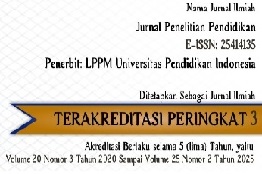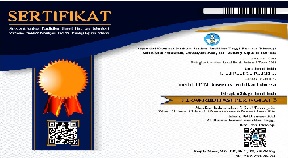Pengembangan 7Cs Melalui Outdoor Education Dalam Rangka Positive Youth Development
Abstract
Keywords
Full Text:
PDF (Bahasa Indonesia)References
CASEL Guide: Effective Social and Emotional Learning Programs-Middle and High School Edition. (2015).
Adams, B. G., Wiium, N., & Abubakar, A. (2019). Developmental Assets and Academic Performance of Adolescents in Ghana, Kenya, and South Africa. Child and Youth Care Forum, 48(2), 207–222. https://doi.org/10.1007/s10566-018-9480-z
Amodeo, M., & Collins, M. E. (2007). Using a Positive Youth Development Problem-Oriented Youth Behavior. 1996, 75–85.
Anika Frühauf, Dominik Sagmeister & Martin Kopp (2023). Barriers to and opportunities for integrating climbing in physical education, Journal of Adventure Education and Outdoor Learning, DOI: 10.1080/14729679.2023.2236255
Anthony, E. K., Alter, C. F., & Jenson, J. M. (2009). Development of a Risk and Resilience-Based Out-of-School Time Program for Children and Youths. 45–55.
Ayotte-Beaudet, J. -P., & Potvin, P. (2020). Factors related to students’ perception of learning during outdoor science lessons in schools’ immediate surroundings. Interdisciplinary Journal of Environmental and Science Education, 16(2), 13. https://doi.org/10.29333/ijese/7815
Barbot, B., & Heuser, B. (2017). Creativity and identity formation in adolescence: A developmental perspective. In M. Karwowski & J. C. Kaufman (Eds.), Explorations in creativity research. The creative self: Effect of beliefs, self-efficacy, mindset, and identity (pp. 87–98). London: Elsevier Academic Press.
Beames, S., Mackie, C., Scrutton, R., & Beames, S. (2018). Alumni perspectives on a boarding school outdoor education programme programme. Journal of Adventure Education and Outdoor Learning, 00(00), 1–15. https://doi.org/10.1080/14729679.2018.1557059
Bean, C., & Forneris, T. (2016). Examining the Importance of Intentionally Structuring the Youth Sport Context to Facilitate Positive Youth Development, 3200(June), 0–16.
Becker, C., Lauterbach, G., Spengler, S., Dettweiler, U., & Mess, F. (2017). Effects of regular classes in outdoor education settings: A systematic review on students’ learning, social and health dimensions. In International Journal of Environmental Research and Public Health (Vol. 14, Issue 5). MDPI. https://doi.org/10.3390/ijerph14050485
Benzies, K., & Mychasiuk, R. (2009). Fostering family resiliency : a review of the key protective factors. 103–114. https://doi.org/10.1111/j.1365-2206.2008.00586.x
Bowen, D. J., & Neill, J. T. (2016). Effects of the PCYC Catalyst outdoor adventure intervention program on youths life skills, mental health, and delinquent behaviour. International Journal of Adolescence and Youth, 21(1), 34–55. https://doi.org/10.1080/02673843.2015.1027716
Bowers, E. P., Larson, L. R., & Sandoval, A. M. (2019). Urban Youth Perspectives on the Benefits and Challenges of Outdoor Adventure Camp. 14(4), 122–143. https://doi.org/10.5195/jyd.2019.809
Bowers, E. P., Li, Y., Kiely, M. K., Brittian, A., Lerner, J. V., & Lerner, R. M. (2010). The Five Cs model of positive youth development: A longitudinal analysis of confirmatory factor structure and measurement invariance. Journal of Youth and Adolescence, 39(7), 720–735. https://doi.org/10.1007/s10964-010-9530-9
Bronfenbrenner, U., & Morris, P. A. (2006). The bioecological model of human development. In R. M. Lerner, & W. Damon (Eds.), Hand- book of child psychology: Theoretical models of human development (pp. 793–828). John Wi- ley & Sons Inc.
Buenconsejo, J. U., & Datu, A. D. (2022). Toward an Integrative Paradigm of Positive Youth Development : Implications for Research, Practice, and Policy. 381–396. https://doi.org/10.1159/000527122
Catalano, R. F., Berglund, M. L., Ryan, J. A. M., Lonczak, H. S., & Hawkins, J. D. (2002). Positive youth development in the United States: Research findings on evaluations of positive youth development programs. Prevention & Treatment, 5(1). https://doi.org/10.1037/1522-3736.5.1.515a
Catalano, R. F., Berglund, M. L., Ryan, J. A. M., Lonczak, H. S., & Hawkins, J. D. (2004). Positive Youth Development in the United States: Research Findings on Evaluations of Positive Youth Development Programs. In Annals of the American Academy of Political and Social Science (Vol. 591, pp. 98–124). https://doi.org/10.1177/0002716203260102
Chapin, L. A., Fowler, M. A., & Deans, C. L. (2021). The role of adult facilitators in arts ‐ based extracurricular settings : Perceived factors for success of adult – youth relationships. December 2020. https://doi.org/10.1002/jcop.22513
Ciotto, C. M., & Gagnon, A. G. (2018). Promoting Social and Emotional Learning in Physical Education. Journal of Physical Education, Recreation and Dance, 89(4), 27–33. https://doi.org/10.1080/07303084.2018.1430625
Corcoran, R. P., Cheung, A. C. K., Kim, E., & Xie, C. (2018). Effective universal school-based social and emotional learning programs for improving academic achievement: A systematic review and meta-analysis of 50 years of research. In Educational Research Review (Vol. 25, pp. 56–72). Elsevier Ltd. https://doi.org/10.101
Paricio, D., Rodrigo, M. F., Viguer, P., & Herrera, M. (2020). Positive adolescent development: Effects of a psychosocial intervention program in a rural setting. International Journal of Environmental Research and Public Health, 17(18), 1–17. https://doi.org/10.3390/ijerph17186784
Povilaitis, V., & Tamminen, K. A. (2017). Delivering Positive Youth Development at a Residential Summer Sport Camp. https://doi.org/10.1177/0743558417702478
Reisman, F., Keiser, L., & Otti, O. (2016). Development, Use and Implications of Diagnostic Creativity Assessment App, RDCA – Reisman Diagnostic Creativity Assessment. Creativity Research Journal, 28(2), 177–187. https://doi.org/10.1080/10400419.2016.1162643
Richards, K. A. R., Ivy, V. N., Wright, P. M., & Jerris, E. (2019). Combining the Skill Themes Approach with Teaching Personal and Social Responsibility to Teach Social and Emotional Learning in Elementary Physical Education. Journal of Physical Education, Recreation and Dance, 90(3), 35–44. https://doi.org/10.1080/07303084.2018.1559665
Rose, J., & Paisley, K. (2012). White Privilege in Experiential Education: A Critical Reflection. Leisure Sciences, 34(2), 136–154. https://doi.org/10.1080/01490400.2012.652505
Rose, L., Williams, I. R., Olsson, C. A., & Allen, N. B. (2018). Promoting Adolescent Health and Well-Being Through Outdoor Youth Programs: Results From a Multisite Australian Study. Journal of Outdoor Recreation, Education, and Leadership, 10(1), 33–51. https://doi.org/10.18666/jorel-2018-v10-i1-8087
Ryan, R. M., & Deci, E. L. (1985). Self-Determination Theory and the Facilitation of Intrinsic Motivation, Social Development, and Well-Being Self-Determination Theory.
Schmid, K. L., Phelps, E., Kiely, M. K., Napolitano, C. M., Boyd, M. J., & Lerner, R. M. (2011). The role of adolescents’ hopeful futures in predicting positive and negative developmental trajectories: Findings from the 4-H study of positive youth development. Journal of Positive Psychology, 6(1), 45–56. https://doi.org/10.1080/17439760.2010.536777
Shek, D. T. L., & Chai, W. (2020). The impact of positive youth development attributes and life satisfaction on academic well-being: A longitudinal mediation study. Frontiers in Psychology, 11, 2126.
Shek, D. T. L., & Zhu, X. (2019). Paternal and maternal influence on delinquency among early adolescents in Hong Kong. International Journal of Environmental Research and Public Health, 16(8). https://doi.org/10.3390/ijerph16081338
Shellman, A., & Hill, E. (2017). Flourishing through Resilience: The Impact of a College Outdoor Education Program. Journal of Park and Recreation Administration, 35(4), 59–68. https://doi.org/10.18666/jpra-2017-v35-i4-7779
Sieng, M., Cloutier, S., & Irimata, K. (2018). Positive Youth Development Sustainability Scale ( PYDSS ): The Development of an Assessment Tool. 10(1), 81–97. https://doi.org/10.5590/JOSC.2018.10.1.07
Skinner, E. A., Rickert, N. P., Vollet, J. W., & Kindermann, T. A. (2022). The complex social ecology of academic development: A bioecological framework and illustration examining the collective effects of parents, teachers, and peers on student engagement. Educational Psychologist, 57(2), 87–113.
Snyder, F. J., & Flay, B. R. (n.d.). Positive youth development School-based tobacco cessation View project Methodology View project. https://www.researchgate.net/publication/255950053
Statistik Pemuda Indonesia 2023. (n.d.).
Taylor, R. D., Oberle, E., Durlak, J. A., & Weissberg, R. P. (2017). Promoting Positive Youth Development Through School-Based Social and Emotional Learning Interventions: A Meta-Analysis of Follow-Up Effects. Child Development, 88(4), 1156–1171. https://doi.org/10.1111/cdev.12864
Theokas, C., Almerigi, J. B., Lerner, R. M., Dowling, E. M., Benson, P. L., Scales, P. C., & Von Eye, A. (2005). Conceptualizing and modeling individual and ecological asset components of thriving in early adolescence. In Journal of Early Adolescence (Vol. 25, Issue 1, pp. 113–143). https://doi.org/10.1177/0272431604272460
Tina Braun & Paul Dierkes (2016). Connecting students to nature-how intensity of nature experience and student age influence the success of outdoor education programs. Environmental Education Research. 10.1080/13504622.2016.1214866
Tolan, P., Ross, K., Arkin, N., Godine, N., & Clark, E. (2016). Toward an integrated approach to positive development: Implications for intervention. In Applied Developmental Science (Vol. 20, Issue 3, pp. 214–236). Psychology Press. https://doi.org/10.1080/10888691.2016.1146080
Uhls, Y. T., Michikyan, M., Morris, J., Garcia, D., Small, G. W., Zgourou, E., & Greenfield, P. M. (2014). Five days at outdoor education camp without screens improves preteen skills with nonverbal emotion cues. Computers in Human Behavior, 39, 387–392. https://doi.org/10.1016/j.chb.2014.05.036
Vaclavik, D., Gray, T., Sánchez, B., Buehler, K., & Rodriguez, E. (2017). How to support me in connected learning.
DOI: https://doi.org/10.17509/jpp.v25i1.81541
Refbacks
- There are currently no refbacks.
Copyright (c) 2025 Jurnal Penelitian Pendidikan


